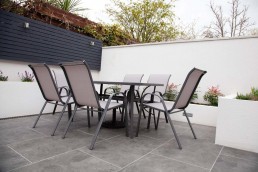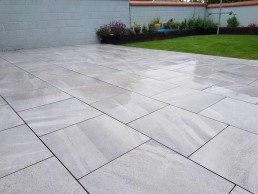Everything You Need to Know Before Paving Your Garden
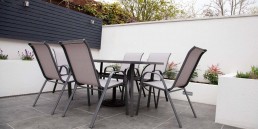
Laying patio slabs is a popular DIY project that can enhance the appearance and functionality of your outdoor living space. However, there are some important factors to consider before starting the project to ensure it is completed correctly and efficiently. Here is everything you need to know before laying patio slabs.
1. Plan and design your patio
Before laying patio slabs, it is important to plan and design your patio. Consider the size, shape, and location of your patio. Measure the area where you want to lay the patio and decide on the layout of the slabs. It is also important to consider the purpose of your patio, whether it is for dining, entertaining, or relaxation. This will help determine the size and shape of the patio.
2. Choose the right materials
Choosing the right materials for your patio is essential for a long-lasting and durable surface. The most popular materials for patio slabs are natural stone, porcelain, and concrete. Each material has its own advantages and disadvantages, so it is important to choose the right material for your specific needs. Natural stone slabs are known for their unique beauty and durability, while porcelain slabs are low-maintenance and resistant to stains and scratches. Concrete slabs are affordable and easy to install.
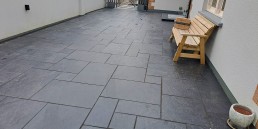
3. Prepare the ground
The ground where you plan to lay the patio slabs should be level and free from any debris. Start by removing any existing grass, plants, or weeds in the area. Then, level the ground by removing any bumps or dips. Add a layer of gravel or sand to create a stable base for the patio slabs. The depth of the base layer will depend on the type of patio slabs you are using and the climate in your area.
4. Lay the patio slabs
Before laying the patio slabs, arrange them in the desired pattern and make sure they fit together properly. Start laying the slabs from one corner of the patio and work your way across. Use a rubber mallet to gently tap the slabs into place and ensure they are level. Use spacers between the slabs to create even gaps for grouting.
5. Cut the slabs to size
In some cases, you may need to cut the patio slabs to fit in a specific area or around an obstacle. Use a diamond blade saw or a masonry chisel and hammer to cut the slabs to size. Make sure to wear protective gear such as gloves and eye goggles while cutting the slabs.
6. Fill the gaps
After laying the patio slabs, fill the gaps between them with grout. This will help secure the slabs in place and prevent weeds from growing between them. There are different types of grout available, including sand-based and resin-based. Choose the right type of grout for your specific needs and follow the manufacturer’s instructions for application.
7. Maintain the patio
Proper maintenance is essential for keeping your patio in good condition. Regularly sweep and clean the patio to remove any debris or dirt. Use a pressure washer to remove any stubborn stains or dirt buildup. Apply a sealant to the patio slabs to protect them from weather damage and stains. It is also important to fix any cracks or damages to the patio slabs as soon as they occur to prevent further damage.
In conclusion, laying patio slabs can be a rewarding DIY project that adds value and functionality to your outdoor living space. By planning and designing your patio, choosing the right materials, preparing the ground, laying the slabs correctly, cutting them to size, filling the gaps, and maintaining the patio properly, you can create a beautiful and durable patio that will last for years to come.
8 Reasons Why You Should Consider Sandstone Paving
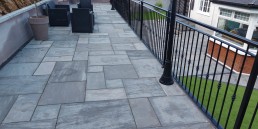
If you are looking for a natural stone paving option for your outdoor space, sandstone is an excellent choice. Sandstone is a sedimentary rock formed by the consolidation and compaction of sand and is known for its natural, earthy appearance. Sandstone paving has become increasingly popular due to its durability, natural beauty, and versatility.
Here are some of the top benefits of using sandstone paving in your garden:
-
Durability
Sandstone is known for its durability and can withstand harsh weather conditions, making it an ideal choice for outdoor spaces. Sandstone is a natural stone, so it can withstand exposure to the elements without losing its color or texture over time. It is also resistant to scratches and abrasions, making it a great option for high traffic areas like patios and walkways.
-
Variety
Sandstone is available in a wide range of colours and patterns, making it easy to find the perfect match for your outdoor space. From warm tones like beige and tan to cooler hues like grey and blue, sandstone can complement any landscaping design. It also comes in a variety of finishes, including natural, honed, and sawn, allowing you to customise the look of your paving.
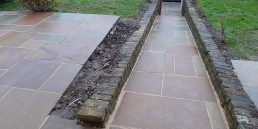
-
Cost-Effective
Sandstone is a cost-effective option for natural stone paving. It is less expensive than other natural stone options like granite or marble, making it a great choice for those on a budget. Additionally, sandstone can last for many years with minimal maintenance, making it a wise long-term investment.
-
Slip Resistance
Sandstone paving is naturally slip-resistant, making it a safe choice for areas that may become wet or slick, such as around swimming pools or near water features. The surface of sandstone has a natural texture that provides traction, reducing the risk of slips and falls.
-
Eco-Friendly
Sandstone is a sustainable building material that is environmentally friendly. It is a natural stone that is mined from the earth and does not require any chemicals or treatments to be produced. Additionally, sandstone is a non-toxic material, making it safe for plants and animals.
-
Versatility
Sandstone paving is incredibly versatile and can be used in a variety of landscaping applications. It is ideal for use as a patio, walkway, or driveway, and can also be used as wall cladding or to create outdoor fireplaces and fire pits.
-
Aesthetically Pleasing
Finally, sandstone paving is aesthetically pleasing and can enhance the overall appearance of your outdoor space. It has a natural, earthy beauty that can complement any landscaping design, and its warm tones and texture can create a cozy, inviting atmosphere.
In conclusion, sandstone paving is a great option for those looking for a durable, cost-effective, and low-maintenance natural stone paving solution. Its versatility and natural beauty make it a perfect addition to any outdoor space. If you are considering sandstone paving for your garden or outdoor space, be sure to choose a reputable supplier to ensure quality materials and professional installation.
The Advantages of Limestone Paving

Limestone paving is a popular choice for garden landscaping due to its natural beauty and durability. It is a sedimentary rock formed by the accumulation of organic materials such as shells, coral, and other debris. Limestone is widely used in construction and is a great option for garden paving due to its many benefits.
Here are some of the key benefits of using limestone paving in your garden:
- Durability: Limestone is a very durable material that can withstand heavy foot traffic and extreme weather conditions. It is also resistant to scratches and chips, making it ideal for outdoor use.
- Natural beauty: Limestone has a natural, earthy look that can add a touch of elegance and sophistication to your garden. It comes in a variety of colors and textures, ranging from light beige to dark gray, and can be polished to a high shine or left with a more rustic, natural finish.
- Low maintenance: Limestone is relatively low maintenance and requires minimal cleaning and upkeep. It does not require sealing or regular maintenance, making it a convenient option for homeowners.
- Slip-resistant: Limestone has a slightly rough texture, which makes it slip-resistant even when wet. This makes it a safe option for garden paths, patios, and pool surrounds.
- Eco-friendly: Limestone is a natural material that is environmentally friendly and sustainable. It is a great alternative to concrete or other man-made materials, which can have a negative impact on the environment.
- Versatility: Limestone is a versatile material that can be used for a variety of garden landscaping projects. It can be used for paving, edging, retaining walls, and more, making it a great option for creating a cohesive and coordinated garden design.
- Value for money: Limestone paving is a great value for money option for garden landscaping. It is a cost-effective material that is both durable and attractive, making it a great investment for homeowners.
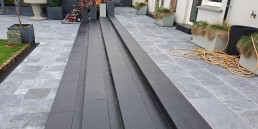
When it comes to choosing the right type of limestone paving for your garden, there are several factors to consider. These include the color and texture of the limestone, the size and shape of the paving stones, and the overall design of your garden.
Limestone is available in a variety of colors, ranging from light beige to dark gray. The color you choose will depend on the overall color scheme of your garden, as well as your personal preference. Lighter colors can help to brighten up a dark garden, while darker colors can add a touch of elegance and sophistication.
In terms of texture, limestone can be left with a natural, rustic finish or polished to a high shine. The texture you choose will depend on the overall design of your garden and the look you are trying to achieve. Natural finish limestone is great for creating a more rustic, natural look, while polished limestone is ideal for creating a more modern, sophisticated design.
When it comes to the size and shape of the limestone paving stones, there are a variety of options available. Larger paving stones can help to create a more open, spacious feel in your garden, while smaller stones can be used to create a more intricate, detailed design. The shape of the paving stones can also vary, with rectangular and square stones being the most common options.
Overall, limestone paving is a great choice for garden landscaping due to its natural beauty, durability, and versatility. Whether you are looking to create a rustic, natural look or a modern, sophisticated design, limestone paving is a great option that can help you achieve your desired look.
7 Benefits of Porcelain Paving
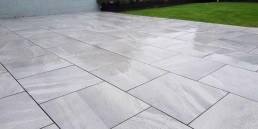
Porcelain paving is a popular choice for outdoor spaces due to its durability, low-maintenance, and versatility. Whether you’re looking to enhance the look of your patio, walkway, or garden path, porcelain paving is a smart investment. Here are some of the top benefits of using porcelain paving in your garden:
-
Durability
Porcelain paving is made from a blend of natural materials, such as clay and sand, that are fired at high temperatures. This process creates a dense, hard-wearing material that can withstand heavy foot traffic, extreme weather conditions, and other outdoor elements. Porcelain paving is also resistant to scratches, stains, and fading, making it a long-lasting option for your garden.
-
Low-maintenance
Porcelain paving is incredibly easy to maintain, requiring little effort to keep it looking its best. Unlike natural stone, porcelain paving doesn’t require sealing or special cleaning products, and it’s resistant to mold and mildew growth. Regular sweeping and occasional mopping are all that’s needed to keep your porcelain paving looking clean and beautiful.

-
Versatility
Porcelain paving comes in a range of colors, sizes, and finishes, making it a versatile choice for any garden design. Whether you’re looking for a sleek, modern look or a more traditional style, there’s a porcelain paving option to suit your needs. You can even use porcelain paving to create unique patterns and designs to add a personal touch to your garden.
-
Slip-resistant
Porcelain paving is slip-resistant, even when wet, making it a safe choice for outdoor areas. This is especially important for families with children or elderly individuals who may be more prone to slips and falls. Slip-resistant porcelain paving can help prevent accidents and injuries, giving you peace of mind when enjoying your outdoor space.
-
Sustainable
Porcelain paving is a sustainable choice for your garden. It’s made from natural materials and doesn’t require harmful chemicals or treatments to maintain its appearance. Additionally, porcelain paving can be recycled at the end of its life, reducing waste and minimizing its impact on the environment.
-
Cost-effective
While porcelain paving may have a higher upfront cost compared to other paving options, its long-lasting durability and low-maintenance requirements make it a cost-effective choice in the long run. You won’t have to worry about constantly replacing or repairing your porcelain paving, saving you money on costly repairs and replacements over time.
-
Increases property value
Porcelain paving can add value to your property by enhancing the look and functionality of your outdoor space. A well-designed garden with quality porcelain paving can increase your property’s curb appeal, making it more attractive to potential buyers if you decide to sell your home in the future.
In conclusion, porcelain paving is an excellent choice for your garden due to its durability, low-maintenance, versatility, slip-resistance, sustainability, cost-effectiveness, and property value enhancement. By investing in porcelain paving for your garden, you can create a beautiful, functional, and long-lasting outdoor space that you’ll enjoy for years to come.

